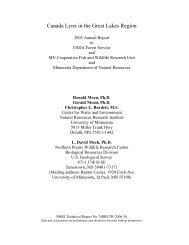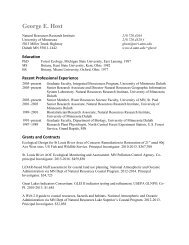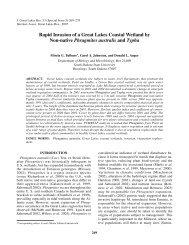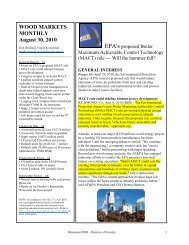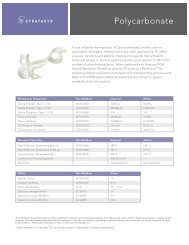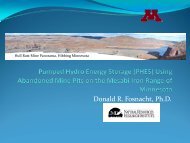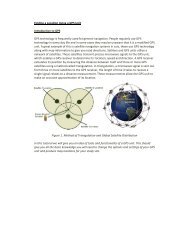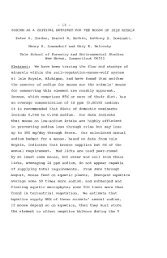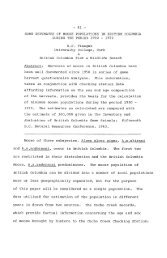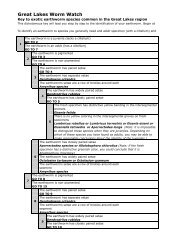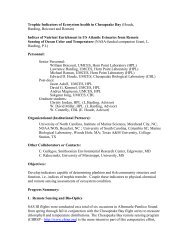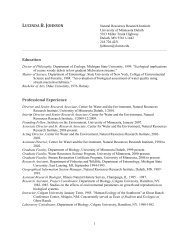Spring/Summer 2010 - Natural Resources Research Institute
Spring/Summer 2010 - Natural Resources Research Institute
Spring/Summer 2010 - Natural Resources Research Institute
Create successful ePaper yourself
Turn your PDF publications into a flip-book with our unique Google optimized e-Paper software.
NRRI Now<br />
<strong>Spring</strong>/<strong>Summer</strong> <strong>2010</strong><br />
2<br />
3<br />
Moose on the loose<br />
The power of peat<br />
4<br />
Food chain foundations<br />
6<br />
De-springing springs<br />
7<br />
Award-winning replica<br />
8<br />
10<br />
Iwao Iwasaki: Like a rock<br />
Ups and downs of lake levels<br />
12<br />
South American connection<br />
This photo of a bull moose was taken in<br />
June <strong>2010</strong> by Josh Hett of Aurora, Ill.,<br />
who submitted it to the moose project website.<br />
~Growing Strong Industries<br />
~Developing New Ideas<br />
~Nurturing <strong>Natural</strong> <strong>Resources</strong>
GRAND FORKS, ND<br />
Only one thing seems certain about moose – they<br />
remain an interesting mystery. That’s surprising<br />
given the evidence that Homo sapiens have<br />
hunted moose as far back as the Stone Age.<br />
It’s not for lack of trying to learn more. In late June, 140<br />
scientists from the U.S. and around the globe – Sweden,<br />
Norway, Germany and Canada – gathered in International<br />
Falls, Minn., for the 45th Annual North American Moose<br />
Conference and Workshop. And like the range of researchers,<br />
the information shared was all over the map.<br />
In Quebec, wildlife managers are concerned that too many<br />
moose are munching down the forests. Wyoming researchers<br />
are documenting a decline in moose populations. In New<br />
England, there’s a problem with a thriving moose population<br />
and moose-vehicle collisions. Scientists also shared something<br />
they’d never seen before – a video of wolves swimming out to<br />
attack a moose in the water.<br />
Here in Minnesota, scientists have recorded the dramatic<br />
decline of moose in the northwestern half of the state and are<br />
now concerned about declining populations in the northeastern<br />
half. Yet our neighbors in North Dakota are seeing moose in<br />
western and southern prairie ranges that are not typical for<br />
this species.<br />
“This conference gives us the chance to talk about data and<br />
new ideas that will lead to a better understanding of the<br />
challenges moose face,” said NRRI biologist and conference<br />
co-chair Ron Moen. “Solutions are possible when we invest in<br />
research on animals and habitat.”<br />
Minnesotans love their large, lumbering, iconic moose.<br />
They are also a prized game for hunters. Studying moose is<br />
expensive but research funding received over the past year<br />
in Minnesota should help increase our understanding of this<br />
super-sized member of the deer family.<br />
Current research is focused on the evolving complexities in the<br />
environment – warming temperatures, explosions of winter<br />
ticks, changes in wolf populations, predicted changes to forest<br />
vegetation – and how they affect moose.<br />
“Our northeast moose population is declining, but we’re not<br />
confident it’s as simple as warming temperatures. Dew point<br />
might be just as important because it affects how much cooling<br />
a moose can do,” explained Mark Lenarz, a biologist with the<br />
Minnesota Department of <strong>Natural</strong> <strong>Resources</strong>. He cites disease<br />
and parasites as the major causes of mortality.<br />
2<br />
INTERNATIONAL FALLS<br />
GRAND<br />
RAPIDS<br />
QUETICO<br />
DULUTH<br />
BWCA<br />
GRAND<br />
MARAIS<br />
<strong>Research</strong>ers were surprised when<br />
moose sightings were being<br />
reported in the western range of<br />
Minnesota. Reports of moose can<br />
be sent to www.nrri.mn.edu/moose.<br />
Where are the<br />
moose All<br />
over the map<br />
Moose researchers<br />
discuss divergent studies<br />
at annual conference<br />
“We believe that some aspect of climate change<br />
make moose less able to fight off the effects of<br />
these pathogens,” Lenarz added.<br />
Radiotelemetry and Global Positioning System<br />
collars have been used on moose to understand<br />
home range, habitats, and movements in many<br />
locations. For the next three years Moen, working<br />
with many other scientists, will be deploying<br />
collars on Minnesota moose.<br />
“These collars are the best tools to help us<br />
understand why and how moose could be<br />
declining in Northeast Minnesota,” Moen said.<br />
“It will also help us develop habitat management<br />
guidelines that could give moose a better chance to<br />
persist in Minnesota.”<br />
Moen is working with researchers from the Grand<br />
Portage Band of Chippewa, Voyageurs National<br />
Park, the 1854 Treaty Authority, the Minnesota<br />
Zoological Garden, the U.S. Geological Survey<br />
and the Minnesota DNR.<br />
Moose stressors<br />
• z Warming temperatures – Moose can become<br />
heat-stressed when summer temperatures reach<br />
60-70 degrees F, or when winter temperatures<br />
are above 32 degrees F. They tend to eat less<br />
and become weakened.<br />
• z White-tailed deer – Increased deer populations<br />
appear to be linked to parasites and diseases<br />
in moose. Less severe winters also increase<br />
parasites and disease.<br />
• z Liver fluke – This flatworm is a deer parasite<br />
that moose can acquire. It isn’t always fatal in<br />
moose but it damages the liver and potentially<br />
weakens the moose’s immune system.<br />
• z Winter ticks – While uninterested in human<br />
hosts, an average of 33,000 ticks, and as many<br />
as 100,000, can be found on one moose. The<br />
feeding ticks can cause substantial blood loss,<br />
and moose rub off their hair coat trying to get rid<br />
of the ticks.
The power of peat<br />
A natural solution for industrial waste water<br />
Many<br />
industrial<br />
processes<br />
require water for<br />
heating, cooling,<br />
cleaning or rinsing.<br />
But before the water<br />
is discharged and<br />
returned to surface<br />
waters, it has to be<br />
treated—typically<br />
with chemicals.<br />
NRRI chemist<br />
Igor Kolomitsyn<br />
(shown right) is<br />
developing a way<br />
to enhance the natural ability of<br />
peat to attract and store toxic heavy<br />
metals to treat industrial waste water.<br />
Even better, he’s working with a<br />
small peat company based in Aitkin,<br />
Minn., to expand their product<br />
line with environmentally friendly<br />
water treatment solutions for heavy<br />
industry.<br />
NRRI’s chemistry research and<br />
American Peat Technology’s<br />
marketing and industry know-how<br />
is an ideal partnership. And it’s what<br />
NRRI was established to do: help<br />
Minnesota’s natural resource-based<br />
businesses grow and thrive in an<br />
environmentally sound manner.<br />
“Being a small company, NRRI<br />
provides us with chemical research<br />
that we just don’t have the resources<br />
to accomplish ourselves,” said<br />
American Peat’s<br />
President, Doug<br />
Green. The company<br />
does about $3.8 million<br />
in sales annually with<br />
about 15 employees.<br />
“We get short term<br />
access to high caliber<br />
chemists allowing<br />
rapid product<br />
development and<br />
early entry into the<br />
marketplace.”<br />
For Kolomitsyn, the<br />
arrangement allows<br />
him to focus on<br />
chemistry, leaving<br />
the business-end to<br />
the business people.<br />
“I have the idea for<br />
this product, but I<br />
don’t have time for<br />
market research,”<br />
said Kolomitsyn.<br />
“If I spend time<br />
on that, I’m not a<br />
chemist anymore.<br />
American Peat is in the best<br />
position to move it forward.”<br />
Peat is partially decayed vegetation<br />
that accumulates in wetland bogs,<br />
and about 15 percent of Minnesota is<br />
covered with this valuable resource.<br />
Minnesota’s peat industry—mostly<br />
harvesting and packaging for<br />
horticultural purposes—provides<br />
about 200 jobs in rural areas where<br />
work can be scarce. American<br />
Peat, founded in 2003, develops<br />
environmentally beneficial products<br />
that can replace chemicals for<br />
agricultural and remediation<br />
purposes.<br />
“I’ve had a whole lifetime in the<br />
business world and I’ve developed an<br />
ability to see market potential,” said<br />
Green. “But our labs are under Igor’s<br />
direction. He’s part of our team and<br />
he gives credibility to the research.<br />
We’re very quick to incorporate<br />
what Igor comes up with.”<br />
No sooner had the ink dried on<br />
the partnership agreement when<br />
two customers came<br />
knocking – Freeport-<br />
McMoRan, one of the<br />
world’s largest copper<br />
and gold producers,<br />
and the Soudan Mine<br />
in Tower, Minn.—<br />
both of which are<br />
interested in this low<br />
cost way to remove<br />
dissolved heavy<br />
metals for wastewater treatment.<br />
“One of the reasons our business<br />
is growing is because the organic<br />
market is growing,” said American<br />
Peat CEO Tom Eberhardt. “We feel<br />
strongly that, working with Igor and<br />
NRRI, we can continue to develop<br />
peat-based products that are good for<br />
the environment.”<br />
More about American Peat Technology<br />
In the heart of Minnesota’s boggy,<br />
sedge peatlands, American Peat has<br />
developed two forms of microbe carrier<br />
products that are beneficial to growing<br />
crops while reducing the need for<br />
commercial, nitrogen-based fertilizers.<br />
Granulated BioAPT can be inoculated<br />
with bacteria that are beneficial to<br />
crops. Among its many benefits, the<br />
peat granules resist moisture loss<br />
and provide a stable environment<br />
for organisms. The company is the<br />
only supplier of this product to the<br />
Rhizobia industry.<br />
Rhizobia is a naturally occurring<br />
organism that lives in a symbiotic<br />
relationship with legume crops like<br />
soybeans, field peas and lentils,<br />
reducing the need for commercial,<br />
nitrogen-based fertilizers.<br />
They also produce a finely ground<br />
BioAPT product that is used as a seed<br />
coating. The small particles allow for<br />
strong cohesiveness to bind directly to<br />
seeds. Rhizobia living on the attached<br />
peat benefit the root system as soon as<br />
it sprouts.<br />
“We have as many as 50 research<br />
projects going on right now with<br />
peat,” said American Peat CEO<br />
Tom Eberhardt. “Our peat products<br />
are an ideal life support system for<br />
organisms, and we can deliver a high<br />
quality, consistent and reasonably<br />
priced product.”<br />
3
4<br />
Food chain foundations<br />
Microscopic monitoring of the Great Lakes
The foundation that supports<br />
life on earth is the bottom<br />
of the food chain. And<br />
NRRI scientist Euan Reavie and his<br />
team pay close attention to what’s<br />
happening to these microscopic<br />
plants called phytoplankton – also<br />
known as algae.<br />
“They’re important because they<br />
nourish everything above them on<br />
the food chain,” said Reavie. “Algae<br />
numbers are down in Lake Superior<br />
and throughout the Great Lakes<br />
and that’s a big concern for the<br />
fishing industry.”<br />
Motoring around the Great<br />
Lakes on the research vessel Lake<br />
Guardian, the sampling crew<br />
collects liters of lake water (and the<br />
accompanying algae) from 80 sites,<br />
twice a year, from Lake Ontario<br />
in New York to Lake Superior in<br />
Duluth. It is part of the ongoing<br />
monitoring program started in<br />
1983 by the U.S. Environmental<br />
Protection Agency’s Great Lakes<br />
National Program Office.<br />
“There are probably about 50,000<br />
species of phytoplankton in the<br />
Great Lakes, about 500-600 that are<br />
common, and each species has a lot<br />
of meaning,” said Reavie. “Some<br />
are tolerant of pollution and if they<br />
start to increase in number, then<br />
you know you have a problem.”<br />
While 20 years ago an<br />
overabundance of phytoplankton<br />
was a concern, Reavie said the<br />
recent drop in this biomass in the<br />
lakes is puzzling, especially in<br />
Lake Superior.<br />
“At least the other lakes have<br />
excuses, like mussel invasions or<br />
non-native fish eating more than<br />
their fair share,” Reavie said. “But<br />
Lake Superior is very deep, very<br />
oligotrophic, which means there’s<br />
not lot of life there to begin with.”<br />
Reavie and crew – scientists Amy<br />
Kireta, Kitty Kennedy and Lisa<br />
Allinger – collect phytoplankton<br />
samples from the surface down<br />
to as many as 1,000 feet below.<br />
The open waters and 6-to-10 foot<br />
waves are sometimes a challenge,<br />
but the Lake Guardian and their<br />
tools are built for the task.<br />
“We also have an experienced<br />
captain who keeps us pointed in<br />
the right direction and over the<br />
correct GPS point,” added Kireta.<br />
The samples are transported to<br />
a lab on land where the data are<br />
compiled and analyzed. In the<br />
end, it will provide answers to the<br />
extent of changes taking place in<br />
our critical freshwater resources<br />
and the future of the food chain.<br />
Digging deep into the<br />
lakes’ history<br />
Many research projects take place as the<br />
Lake Guardian makes its way around the<br />
Great Lakes twice a year. Complementary<br />
to monitoring the modern conditions of the<br />
lakes, is research that digs into the past.<br />
Hidden in the mud are microscopic glasslike<br />
shells left behind by phytoplankton<br />
decades and centuries ago. Because<br />
these tiny plants are so sensitive to<br />
changes in their environment, the<br />
preserved shells leave clues to changes in<br />
the water quality when they were alive.<br />
NRRI’s Amy Kireta is leading an effort to<br />
collect sediment samples a few feet into<br />
the lake bottom to gather information about<br />
how the lake water quality has changed<br />
over the past 300 years. Terry Brown,<br />
NRRI geographic information systems<br />
specialist, is simultaneously making<br />
computer models of the historic changes<br />
in the surrounding landscape so human<br />
activity can be linked to what is observed<br />
in the sediment.<br />
NRRI will also be partnering with scientists<br />
at UMD’s Large Lakes Observatory who<br />
are using isotopes (atoms that are missing<br />
or have an extra neutron) in the sediments<br />
to determine whether Lake Superior has<br />
been impacted by human activity in the<br />
lake's watersheds or by airborne pollutants<br />
from further away.<br />
Together, the retrospective data and<br />
ongoing monitoring help scientists<br />
understand past changes and future<br />
possibilities for the Great Lakes<br />
ecosystems.<br />
Kitty Kennedy processes samples. Euan Reavie inspects collected samples. Amy Kireta watches as Reavie scraps off<br />
sediment core samples.<br />
5
Taking the spring out of springs<br />
Local innovators help NRRI move mattress recycling forward<br />
The steel springs<br />
in old mattresses<br />
posed a conundrum<br />
that frustrated NRRI<br />
researcher Tim Hagen as<br />
he tried to find markets for<br />
the mattress components.<br />
Steel holds good value in<br />
the recycling industry, yet<br />
the springy springs are like<br />
so much air—they need<br />
to be compressed to ship<br />
efficiently and for a foundry<br />
to melt them down.<br />
Duluth entrepreneur Clint<br />
Deraas learned of the problem through<br />
NRRI and consulted with an inventor<br />
friend, Gene Luoma.<br />
“I thought about it for a bit, then realized<br />
the business potential,” said Deraas. “I<br />
called Gene and asked him if he thought we<br />
could come up with a solution. He said, no<br />
problem.”<br />
First they tested their compaction idea on<br />
a modified hydraulic press. When they got<br />
the results they wanted, they designed the<br />
first ever Coil <strong>Spring</strong> Compactor. Deraas<br />
hired fabricators to assemble it, and after a<br />
couple of modifications, the final machine fit<br />
the need exactly. After the foam, cotton and<br />
shoddy material is separated from the steel,<br />
several springs can be compressed in each<br />
cycle in a completely sealed environment so<br />
stray springs don’t pose a safety hazard. The<br />
steel compresses to a 17x13x9 inch cube with<br />
a density that meets the requirements of<br />
steel foundries nationwide.<br />
NRRI has been working with Goodwill<br />
Industries in Duluth for three years on a<br />
viable mattress recycling business plan, and<br />
finding a way to recycle the steel springs<br />
is the key to making it work economically.<br />
Goodwill bought the prototype Coil <strong>Spring</strong><br />
Compactor and has been very pleased with the results.<br />
The current market value for the compressed springs at<br />
ME Global foundry in Duluth is $213 per ton. This income<br />
allows Goodwill to offer recycling services to other<br />
potential customers.<br />
“Steel has the highest monetary value in the mattress or<br />
box spring,” said Goodwill manager Greg Conkins. “The<br />
6<br />
By the<br />
numbers:<br />
40 million –<br />
approximate<br />
number of<br />
mattresses<br />
purchased annually<br />
in the U.S.<br />
11 – years of life in<br />
typical mattress<br />
50 – percent of<br />
weight from steel in<br />
a typical innerspring<br />
mattress<br />
100 – approx.<br />
number of<br />
mattresses<br />
deconstructed daily<br />
at Goodwill Duluth<br />
30 – approx.<br />
number of<br />
mattresses<br />
deconstructed daily<br />
at PPL Industries in<br />
Minneapolis<br />
Coil <strong>Spring</strong> Compactor<br />
gives us optimal<br />
production efficiency.<br />
We’re hoping to grow this<br />
program even more, and<br />
put more people to work<br />
who have employment<br />
barriers.”<br />
In 2009, PPL Industries<br />
in Minneapolis followed<br />
Duluth’s lead to start a<br />
similar mattress recycling<br />
effort in partnership<br />
with Hennepin County.<br />
Hagen helped them find<br />
markets for their materials and found a<br />
manufacturer, Schmidt Machine Co., to<br />
modify a baling machine that can bale five to<br />
seven mattress springs at a time into 18x24<br />
inch bundles.<br />
“The baler is phenomenal,” said Doug<br />
Jewett, PPL Industries chief operating<br />
officer. “We built a machine that easily<br />
handles the material, very readily. And there<br />
are a number of places in the metro area that<br />
will buy the steel.”<br />
Over 80 percent of a mattress is recyclable,<br />
and both Goodwill and PPL are interested<br />
in expanding their markets for the foam,<br />
cotton, and other materials. Currently,<br />
the mattress foam is being recycled into<br />
carpet underlayment and wood from box<br />
frames is burned as a biomass fuel. Hagen is<br />
working with Mat, Inc., a textile company<br />
in Floodwood, Minn., on potential markets<br />
for the mattress cotton and “shoddy,”<br />
a synthetic composite material. Hagen<br />
hopes that, with the right preparation, the<br />
cotton can continue to be sold to diesel and<br />
locomotive oil filter manufacturers. He also<br />
finds that blends of cotton, shoddy, and a<br />
crimped polyester fiber can be thermally<br />
formed into stormwater filters and molded<br />
pet beds.<br />
Hagen is hoping to get industry partners to help fund<br />
the research from proof-of-concept to demonstration<br />
scale, and then testing and market research.<br />
“We’re particularly excited about the thermal-forming<br />
techniques we’ve developed,” said Hagen. “This could<br />
really close the recycling loop and help achieve our<br />
quest for sustainability.”
Pistol perfection<br />
NRRI builds award-winning replica<br />
“<br />
The heft, the grip, the metal and wood – this is a 1776 English dueling pistol.<br />
Flintlock pistols like this one were some of the most artistic weapons ever<br />
built, and they fetch hundreds of thousands of dollars at auction. You<br />
might even be a little nervous putting your finger on the trigger.<br />
Or not. This one is actually a replica built in NRRI’s rapid prototyping center and<br />
it recently won first place in the 3D Systems Users Group Advanced Finishing<br />
competition. The pistol body was built by Sam Firoozi using a glass-filled nylon<br />
material in the center’s Selective Laser Sintering machine.<br />
“I like old guns so when we were looking for something to build I saw this image<br />
in a catalog online, then I found a three-dimensional model of it,” explained<br />
Firoozi, rapid prototyping specialist. He converted the computer model to the<br />
correct size, and made each piece – a dozen or so – to be painted and assembled.<br />
Mike Cable, NRRI shop technician, took it from there and his painting precision<br />
paid off with the award. Each piece was sanded with sandpaper, primed and<br />
This pistol is an excellent example of the precision<br />
we get from our rapid prototyping machines and the<br />
quality of work that our people produce.<br />
”<br />
sprayed with carefully selected paint in four layers.<br />
“The ‘candy’ paint concentrates are so transparent, the<br />
base color really makes a difference in the top layer,”<br />
Cable said. “The paint has fine metal particles in it so it<br />
looks like real metal.”<br />
Lab Director Steve Kossett<br />
It was assembled quickly to get it to the competition<br />
on time – and no glue holds the solid pistol together.<br />
Everything was built precisely and tightly. And to house the fine workmanship,<br />
NRRI’s wood products scientist Scott Johnson built a wooden box which they<br />
fitted with a molded form (also built with rapid prototyping technologies) to hold<br />
the pistol snuggly.<br />
“This pistol is an excellent example of the precision we get from our rapid<br />
prototyping machines and the quality of work that our people produce,” said Lab<br />
Director Steve Kossett. “I’m very proud of the work our technicians do to build a<br />
wide variety of items for numerous manufacturing and testing purposes.”<br />
7
8<br />
Like a rock<br />
A metallurgist’s legacy: A vast repository of<br />
knowledge for the iron and steel industry<br />
Never has a man been more aptly named. “Iwao” is Japanese for “rock.” Iwao Iwasaki, born<br />
in Tokyo, Japan in 1929, has lived a life dedicated to Minnesota’s ores and minerals. Today, at<br />
age 81, he continues that dedication as NRRI Endowed Taconite Chair, lending his lifetime of<br />
mining and metallurgical processing expertise to benefit Iron Range industries.<br />
It wasn’t exactly his plan to live more of his life in Minnesota than in Japan, but opportunities<br />
kept unfolding, and with each opportunity came Iwasaki’s increased desire to give back to the<br />
state he now calls<br />
home.<br />
He first came to<br />
Minnesota in 1950<br />
at age 20 to spend a<br />
summer with a pen<br />
pal’s family. This<br />
led him to apply to<br />
the University of<br />
Minnesota where<br />
he received tuition<br />
scholarships. He<br />
made connections<br />
there that led<br />
him to the<br />
prestigious MIT<br />
(Massachusetts<br />
<strong>Institute</strong> of<br />
Technology)<br />
which launched<br />
Iwasaki into new<br />
discoveries in iron<br />
ore flotation – the<br />
vital process of<br />
separating the good<br />
ores from the bad.<br />
“Iwao’s lifelong<br />
research career<br />
has played a key<br />
role in the success<br />
of the Minnesota iron ore industry, supplying iron ore pellets to this country’s blast furnace<br />
steelmaking industry,” said Dave Hendrickson, NRRI minerals lab director. “And his work<br />
continues to be highly respected by all of our Minnesota and Michigan taconite operations, as<br />
well as by large steel company partners, such as U.S. Steel, Mittal and Nucor.”<br />
A little ‘black magic’<br />
From Tokyo to Minnesota's Iron Range, Iwao Iwasaki has<br />
focused a lifetime of curiousity and talent to making our state's<br />
ore resources as productive as possible.<br />
In Japan they say “Keizoku wa chikara nari” which means, “there is strength in perseverance.”<br />
That philosophy drives Iwasaki’s research. He anticipates at least 10 years to fully understand<br />
each new endeavor.<br />
“I enjoy my work at NRRI… I just wish I was 10 years younger,” said Iwasaki with a grin.<br />
Iwasaki, known as “Pete” to his U.S. friends and coworkers, experienced the devastation of<br />
post-World War II Japan. Manufacturing ramped up and the country had about 500 working<br />
mines. His early college courses in mining engineering were practical, but something else<br />
caught his attention.<br />
“During World War II we were mobilized into factories and I was put into a manufacturing<br />
plant, operating lathes and other machinery,” Iwasaki recalled. “I knew I wasn’t interested<br />
in that. But when I saw an engineer dissolving metals and analyzing colored solutions…that<br />
fascinated me.”
At the University of Minnesota School of Mines<br />
he majored in metallurgy and quickly finished his<br />
Bachelor of Science degree with thoughts of going<br />
back to Japan. The U of M asked him to stay on for<br />
his master’s degree, and because of his fascination in<br />
the flotation process – widely used to separate nonferrous<br />
minerals from sulfides – Iwasaki said “yes” to<br />
understand how flotation could be applied to iron ore.<br />
"I was so excited about the research that I often<br />
worked past midnight."<br />
“I asked the professor, ‘How do you explain, by<br />
choosing different reagents, that you can float white<br />
silica and not float iron oxide or the other way<br />
around’ He told me, ‘It’s black magic.’ So that stayed<br />
in my mind,” said Iwasaki.<br />
A master of flotation<br />
There was a perfect opportunity for flotation studies<br />
on Minnesota’s Cuyuna Range – an iron sulfide<br />
deposit that needed researching. Iwasaki also learned<br />
that Japan had iron sulfide resources that were not<br />
being well-utilized. He hoped his master’s thesis<br />
research could be shared by both countries.<br />
It was during this research that he was supervised by<br />
a former MIT graduate who encouraged Iwasaki to<br />
get his doctorate degree in metallurgy from the highly<br />
reputable University.<br />
“It really opened my eyes,” said Iwasaki. “I was still<br />
focused on flotation, but at MIT, they studied a very<br />
fundamental science of flotation, highly scientific. I<br />
was so excited about the research that I often worked<br />
past midnight. I also felt I had to get back to Japan<br />
because I am my parents only son, so I wanted to<br />
finish quickly.”<br />
And he did. Iwasaki finished his Doctor of Science<br />
degree in two and a half years. He went back to the U<br />
of M’s School of Mines armed with a deep knowledge<br />
of flotation science to research the “black magic” of<br />
iron ore flotation.<br />
Japan, Minnesota, Japan<br />
At age 29 and after two years with the U of M as an<br />
assistant professor, Iwasaki went back to Japan. He<br />
was hired by Nippon Steel as a research engineer<br />
where he learned the industry of iron and steelmaking.<br />
“The research director said to me, ‘Forget about<br />
flotation. Now you’re working for a steel company.<br />
Concentrate on iron making’,” Iwasaki recalled. “So,<br />
I worked on pelletizing, sintering and direct reduction<br />
of iron ores. This gave me a very good background<br />
when I came back to Minnesota.”<br />
In 1963, with the help of then-Senator Hubert H.<br />
Humphrey, Iwasaki moved quickly through the<br />
lengthy visa process so he could get to work at the<br />
U of M’s Mines Experiment Station in Minneapolis.<br />
This was where E. W. Davis developed his process<br />
for turning low-grade taconite into pellets for blast<br />
furnaces, which saved the economy of the Iron Range.<br />
Iwasaki worked there as a professor for 30 years.<br />
“I had many graduate students working with me on<br />
the research there,” said Iwasaki. “But in the 1980s, the<br />
mining industry started its downturn and along with<br />
that, enrollment in the School of Mines, so it closed<br />
in 1991.”<br />
It was time to go back to Japan. Iwasaki was offered a<br />
research position with Mitsubishi Materials in Tokyo.<br />
There, he used hydrometallurgy research on coppernickel<br />
ore that he initiated at the U of M to obtain a<br />
large research grant from the Japanese government.<br />
“The customary retirement age in Japan is 55 . . .<br />
Here I was 70 years old and beginning a new job!”<br />
Iwasaki said with a laugh.<br />
But at the same time, he was encouraged to come<br />
back to Minnesota by NRRI’s Minerals <strong>Research</strong> Lab<br />
Director Rod Bleifuss and others to fill a newly created<br />
Endowed Taconite Chair position at NRRI's Coleraine<br />
Minerals <strong>Research</strong> Lab on the Iron Range.<br />
“My superior at Mitsubishi said, ‘If you go we<br />
won’t have anyone to do the research. We’ll have<br />
to apologize to our government and give the money<br />
back’,” Iwasaki recalled. “Well, I could not do that. I<br />
was sorry I couldn’t go back to Minnesota, but I had to<br />
fulfill my obligation to Mitsubishi.”<br />
Minnesota, again<br />
By the time Iwasaki was 70, he had fulfilled that<br />
obligation and he was ready for retirement. But a<br />
chance meeting with Bleifuss at a mining meeting<br />
reinvigorated their connection. Again, Bleifuss offered<br />
the Endowed Chair position to Iwasaki.<br />
“The customary retirement age in Japan is 55. If you<br />
have a very important position, maybe you retire at<br />
65. Here I was 70 years old and beginning a new job!”<br />
Iwasaki said with a laugh.<br />
The vast experience Iwao Iwasaki has brought to<br />
Minnesota’s iron ore industry has been invaluable.<br />
“Iwao has been and continues to be a model scientist<br />
in our organization,” said NRRI Center Director<br />
Don Fosnacht. “Whether it’s iron ore processing<br />
refinement, iron nodule developments, or new ways<br />
to recycle waste materials, he uses sound science and<br />
his vast knowledge to move our projects ahead in a<br />
dramatic and timely manner. In addition, his ability<br />
to document what he has done in a systematic way<br />
and to do this religiously has produced a record of<br />
accomplishment which will be used for decades into<br />
the future.”<br />
9
Yellow dots show where water level data is collected in the Pokegemma Bay in So. Superior, Wisc., (left)<br />
and in a bay off the St. Louis River near Fond du Lac, Minn (right).<br />
The ups and downs of lake levels<br />
Water level management in Lake Superior<br />
10
Field technicians Bob Hell and Noah<br />
Kroening gather water level data.<br />
<strong>Summer</strong> intern Cory Peterson collects data in<br />
tall reed grass near Oconto, Wisc.<br />
Bob Hell and Noah Kroening collect data up<br />
the estuary shoreline.<br />
Left alone, lake levels naturally<br />
fluctuate—high for about 10<br />
years, then down for another<br />
decade or so.<br />
Lake Superior’s water levels are<br />
managed by locks and dams so<br />
that ships can consistently move<br />
goods through the Great Lakes.<br />
Lakeshore owners also appreciate<br />
consistent lake levels. But the<br />
shoreline meadow marsh habitat,<br />
and the plants and animals that<br />
inhabit it, thrive best with natural<br />
lake level fluctuations over decades.<br />
“Meadow marshes naturally occur<br />
all around the Great Lakes. It’s an<br />
area where, walking through it,<br />
your feet just barely get soggy,”<br />
explained NRRI Aquatic Scientist<br />
Valerie Brady. “It’s home to<br />
unique wild flowers and a lot of<br />
critters.”<br />
Lake Ontario once had rich<br />
meadow marshes, but the desire<br />
to tightly regulate water levels<br />
all but eliminated them there.<br />
Lake Superior is currently being<br />
regulated to mimic normal<br />
fluctuations in water levels, but<br />
there’s a potential policy change on<br />
the table.<br />
The U.S. Army Corps of Engineers<br />
is considering changing the<br />
regulations, so they’re asking<br />
the question: What are the<br />
repercussions of less fluctuation<br />
in water levels in lakes Superior,<br />
Michigan and Huron<br />
Brady received $300,000 to research<br />
what this might mean for the<br />
marshes of the St. Louis River.<br />
She also organized a coalition of<br />
wetland researchers around the<br />
Great Lakes, from Wisconsin to<br />
New York, to share decades of<br />
coastal data. The needs of other<br />
groups – lake shore owners and<br />
the shipping, fishing and tourism<br />
industries – will also be considered<br />
by the regulatory panel in charge of<br />
making this decision.<br />
But getting a scientific answer to<br />
the environmental repercussions<br />
isn’t easy. Detailed elevation maps<br />
(called “bathymetry” from the<br />
Greek, “deep measure”) of the floor<br />
of the coastal wetlands are crucial,<br />
and surprisingly, it hasn’t been<br />
done before.<br />
So that’s the first task. NRRI field<br />
technicians Bob Hell and Noah<br />
Kroening have to boat, walk and<br />
measure their way around three<br />
wetland sites in the St. Louis<br />
River estuary. This summer, they<br />
are collecting data using a high<br />
tech global positioning system.<br />
It will give them high resolution<br />
locations, complete with water<br />
depth or elevation for hundreds to<br />
thousands of points per day. This<br />
data will be translated into a 3D<br />
contour map of the floor of the<br />
estuary and up the banks.<br />
“We want to know, if the water<br />
level changes, where can the<br />
wetland go Is there room for it to<br />
move upland, or are there cliffs or<br />
roads or homes in the way” Brady<br />
explained. “If the water level drops,<br />
can the wetland move downslope<br />
or is there a shipping channel or a<br />
drop-off in depth”<br />
Today’s technology makes<br />
mapping the bathymetry of this<br />
region possible with an accuracy<br />
that wasn’t possible before.<br />
Understanding the contours of the<br />
wetlands will allow the scientists<br />
to predict what changes in the<br />
water management plan for Lake<br />
Superior means for the Great Lakes<br />
coastal wetlands and the fish, bug,<br />
bird and amphibian communities<br />
that depend on them.<br />
affects coastal habitat<br />
11
Check us out: www.nrri.umn.edu<br />
The <strong>Natural</strong> <strong>Resources</strong> <strong>Research</strong> <strong>Institute</strong> was established by the Minnesota Legislature in 1983 to foster economic<br />
development of Minnesota's natural resources in an environmentally sound manner to promote private sector employment.<br />
Michael Lalich, director<br />
Center for Water & the<br />
Environment<br />
Lucinda Johnson, director<br />
Center for Applied <strong>Research</strong><br />
& Technology Development<br />
Donald Fosnacht, director<br />
Center for Economic<br />
Development<br />
Elaine Hansen, director<br />
NRRI Now<br />
June Kallestad, editor/writer<br />
Trish Sodahl, graphic design<br />
NRRI Now<br />
<strong>Natural</strong> <strong>Resources</strong> <strong>Research</strong> <strong>Institute</strong><br />
University of Minnesota, Duluth<br />
5013 Miller Trunk Highway<br />
Duluth Minnesota 55811-1442<br />
Address Service Requested<br />
Non-Profit<br />
Organization<br />
U.S. Postage<br />
Paid<br />
Permit No. 705<br />
Duluth, Minnesota<br />
NRRI Now is published to provide<br />
information about our programs and<br />
projects. For details call (218) 720-4294.<br />
Printed on recycled paper made from 10 percent post-consumer waste with soy ink.<br />
The University of Minnesota is an equal opportunity educator and employer.<br />
NRRI starts chemistry workshop in South America<br />
Reaching across the globe is second nature<br />
to NRRI scientist Subash Basak. Now<br />
he’s strengthening a new South American<br />
connection as co-chair of the Second<br />
Mathematical Chemistry Workshop of<br />
the Americas held in Colombia July 19-24.<br />
Last year’s event, held for the first time in<br />
the southern hemisphere, generated keen<br />
interest in continuing and growing the<br />
workshop. Basak is joined by co-chairs<br />
José L. Villaveces from the Universidad<br />
de los Andes (this year’s sponsor) and<br />
Guillermo Restrepo from the Universidad<br />
de Pamplona, Colombia.<br />
Mathematical chemistry is a consortium<br />
of sciences – chemistry, mathematical<br />
modeling, chemo-informatics,<br />
environmental sciences and toxicology,<br />
quantitative structure-activity<br />
relationship (QSAR) and quantitative<br />
molecular similarity analysis (QMSA)<br />
modeling, bioinformatics (including<br />
genomics and proteomics), and other<br />
relevant fields. This workshop allows<br />
leading researchers in all of these fields to<br />
come together and share knowledge.<br />
2009 Participants (from left): Nubia Quiroz, Andrés Bernal, Tatiana del Pilar<br />
Suárez, Wilmer Oswaldo Leal, Subhash Chandra Basak, Teresa Martínez, José<br />
Luis Villaveces, Francisco Flórez, Rosana del Pilar Suárez<br />
The workshop conference series arose out of interactions<br />
among mathematical chemists from North and South<br />
American countries during their participation in the<br />
two Indo-U.S. events – the Indo-U.S. Workshop on<br />
Mathematical Chemistry and Indo-U.S. Lecture Series on<br />
Discrete Mathematical Chemistry. Basak and coworkers, in<br />
collaboration with Indian colleagues, have been organizing<br />
these events on the UMD campus and in different parts of<br />
India since 1998.



